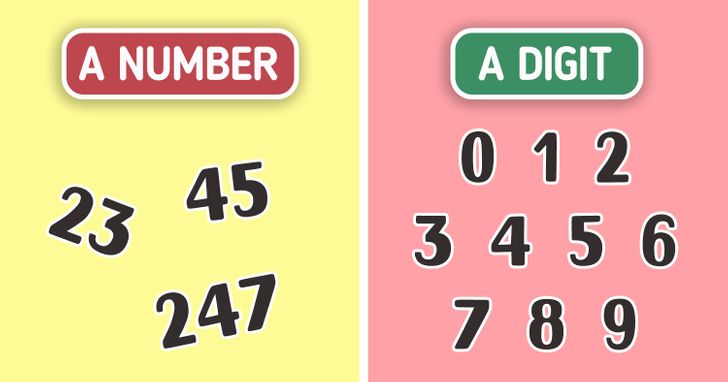The Difference Between a Number and a Digit, and What Babylon Has to Do With It
It seems that there shouldn’t be any difference between a number and a digit. However, there is. And in this article, we’ll study the meaning of these words and find out their history.
At 5-Minute Crafts, we always like to learn something new, and we hope you do too.
How to distinguish a number from a digit

The number system we are accustomed to is Hindu-Arabic. It consists of 10 digits: 0, 1, 2, 3, 4, 5, 6, 7, 8, and 9.
- A digit is a single numerical symbol from 0 to 9.
- A number is a string of 1 or more digits.
For example, 23 is a string of 2 digits. Therefore, it’s a 2-digit number. And 247 is a 3-digit number. But a digit is similar to a letter of the alphabet in a certain sense. One letter or digit can do little. But when you use them as the building blocks for words and numbers, their power becomes apparent. For example, the number 45 is written using 2 digits: 4 and 5.
A number is the amount of something. It can be written with 1 digit. By the way, numbers can also be written with words.
Examples of numbers:
- 3
- 48
- Forty-four
- 14448
- One thousand fifty-six
When numbers were invented

- In the Paleolithic period, primitive people used marks for counting, which were carved on bones, wood, stone, or cave walls. However, as the civilization developed, people realized that they should find a way to record large numbers.
- Many number systems, including Greek, Egyptian, and Hebrew numerals, were only extensions of tally marks. For example, in the Ancient Egyptian system, a coiled rope stood for 100 and a water lily, for 1,000. Each symbol was repeated as many times as necessary, and all were added together. Therefore, in the Ancient Egyptian system, the number 300 would be shown as 3 coiled ropes. But this way of writing was quite difficult to understand.
- The Babylonian, Chinese, and Aztec civilizations independently invented a positional system. It made it possible to reuse the same symbols, assigning them different meanings depending on their position in the sequence. And by the seventh century ACE, Indian mathematicians perfected a decimal positional system, which could represent any number using 10 unique characters. Later, Arab merchants, scientists, and conquerors spread it across Europe.
- A breakthrough in the positional system happened after the appearance of the number 0. The presence and use of this number helped to make the recording of numbers more clear.
- The positional notation doesn’t have to be based around a decimal. The Babylonians invented a base 60 system, and this is still part of the modern time system. For example, we use 60-minute hours and 60-second minutes.